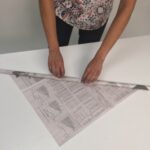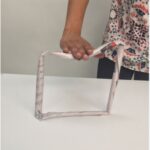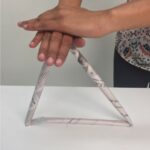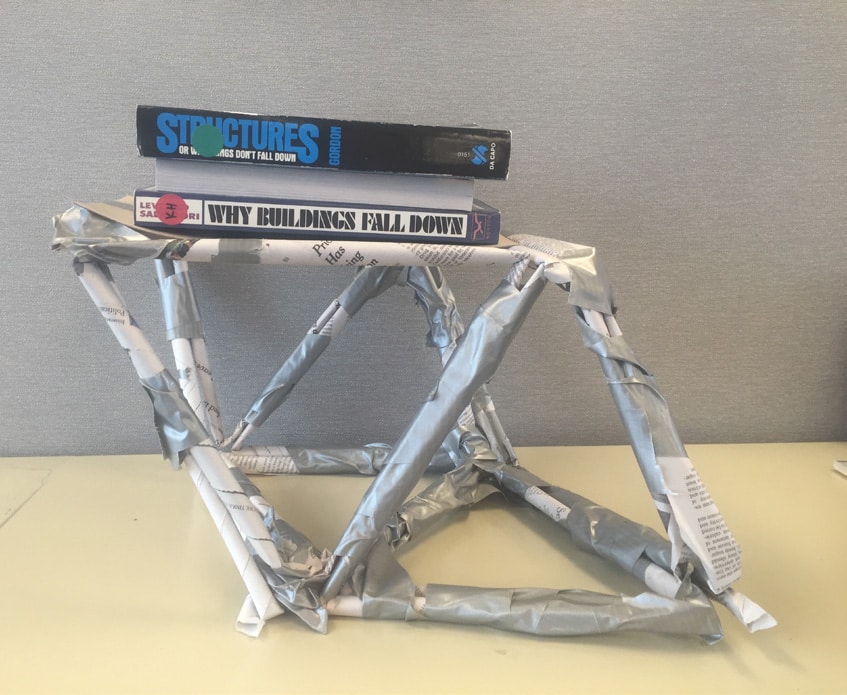Overview
Materials
Per Class:
|
Per Team of 3-4 Students:
|
Instructions
Teams design and build structures made out of newspaper that are at least 8″ tall and that are strong enough to support the weight of several books.
PREPARATION:
Make the following examples to show and discuss with students:
- A tightly rolled tube made of newspaper (Tip: Start at one corner, rolling diagonally toward the other corner.)
- A newspaper tube bent and taped into a triangle shape
- A newspaper tube bent and taped into a rectangle shape
- A loosely rolled newspaper tube
 ACTIVITY:
ACTIVITY:
- Organize students into teams. Elicit student ideas for pros and cons of various shapes to make newspaper into before asking a volunteer to press down on the example rectangle and example triangle. Make sure the following points are clear:
- Tightly rolled tubes are a strong shape because they distribute weight, which pushes on every part of the paper, not just one spot.
 If you make a rectangle or square out of newspaper tubes and press on it, the weight pushes down on just one side. This section can weaken and collapse.
If you make a rectangle or square out of newspaper tubes and press on it, the weight pushes down on just one side. This section can weaken and collapse.- If you make a triangle out of newspaper tubes and press on it, the weight is distributed equally on each side. This even distribution makes a triangle stronger and more stable than a rectangle or square.
- Explain the challenge—to use only newspaper and tape to build a structure at least 8″ tall that can support books— and distribute paper and pencils for the planning phase. Give teams time to sketch some ideas. Tell them that they can build any way they want, so long as they meet the constraints of the challenge. Show them the piece of cardboard that can serve as a platform for the books atop their structure.
-
 Distribute materials and instruct students to build their structures. Troubleshoot as needed, especially for younger students.
Distribute materials and instruct students to build their structures. Troubleshoot as needed, especially for younger students. - As each structure is ready for testing, place a heavy book on it. Tell the teams to observe carefully so that they can see the problem(s) if their structure collapses. If the structure collapses after one book, tell teams to redesign and rebuild for a new test.
Guiding questions
-
What can make tubes stronger if they start to tilt or twist?
-
If your structure collapses, what can you do to stabilize the base?
-
If your tubes are wrinkled, loose, or dented, how will they perform in your structure?
-
How do you think newspaper could be used effectively as the main material to build a house for a family?
Engineering & science connections
- A piece of newspaper only weighs a gram or two, yet when it’s rolled up it can help support a book that weighs several pounds. Strength is created by rolling paper into cylinders. Cylinders are incredibly strong because they disperse stress evenly throughout their entire shape.
- Engineers think about load distribution when they build structures such as buildings and bridges. They need to make sure there are no weak sections. Engineers incorporate triangles, arches, and domes into their structures to distribute weight evenly, and make them strong and stable.
- Believe it or not, there are full-size houses that have been built using mostly paper. A house in Rockport, Massachusetts, was built by a mechanical engineer in the 1920s and is still standing strong. While the framework of the house is wooden, the walls are made from layers and layers of newspaper, which were glued and varnished to strengthen them. The builder lived in the house for 6 years, and then made it into a tourist attraction.
This activity was provided by Design Squad Global.
DESIGN SQUAD GLOBAL is produced by WGBH Boston. Major funding is provided by the National Science Foundation. Project funding is provided by the Lemelson Foundation. The DESIGN SQUAD GLOBAL material is based on work supported by the National Science Foundation under Grant No. 1422236. Any opinions, findings, and conclusions or recommendations expressed in this material are those of the authors and do not necessarily reflect the views of the National Science Foundation. © WGBH Educational Foundation.


0 Comments